Mohamed Elmahallawy
Decentralized Trust for Space AI: Blockchain-Based Federated Learning Across Multi-Vendor LEO Satellite Networks
Dec 09, 2025Abstract:The rise of space AI is reshaping government and industry through applications such as disaster detection, border surveillance, and climate monitoring, powered by massive data from commercial and governmental low Earth orbit (LEO) satellites. Federated satellite learning (FSL) enables joint model training without sharing raw data, but suffers from slow convergence due to intermittent connectivity and introduces critical trust challenges--where biased or falsified updates can arise across satellite constellations, including those injected through cyberattacks on inter-satellite or satellite-ground communication links. We propose OrbitChain, a blockchain-backed framework that empowers trustworthy multi-vendor collaboration in LEO networks. OrbitChain (i) offloads consensus to high-altitude platforms (HAPs) with greater computational capacity, (ii) ensures transparent, auditable provenance of model updates from different orbits owned by different vendors, and (iii) prevents manipulated or incomplete contributions from affecting global FSL model aggregation. Extensive simulations show that OrbitChain reduces computational and communication overhead while improving privacy, security, and global model accuracy. Its permissioned proof-of-authority ledger finalizes over 1000 blocks with sub-second latency (0.16,s, 0.26,s, 0.35,s for 1-of-5, 3-of-5, and 5-of-5 quorums). Moreover, OrbitChain reduces convergence time by up to 30 hours on real satellite datasets compared to single-vendor, demonstrating its effectiveness for real-time, multi-vendor learning. Our code is available at https://github.com/wsu-cyber-security-lab-ai/OrbitChain.git
Explaining the Unseen: Multimodal Vision-Language Reasoning for Situational Awareness in Underground Mining Disasters
Dec 09, 2025Abstract:Underground mining disasters produce pervasive darkness, dust, and collapses that obscure vision and make situational awareness difficult for humans and conventional systems. To address this, we propose MDSE, Multimodal Disaster Situation Explainer, a novel vision-language framework that automatically generates detailed textual explanations of post-disaster underground scenes. MDSE has three-fold innovations: (i) Context-Aware Cross-Attention for robust alignment of visual and textual features even under severe degradation; (ii) Segmentation-aware dual pathway visual encoding that fuses global and region-specific embeddings; and (iii) Resource-Efficient Transformer-Based Language Model for expressive caption generation with minimal compute cost. To support this task, we present the Underground Mine Disaster (UMD) dataset--the first image-caption corpus of real underground disaster scenes--enabling rigorous training and evaluation. Extensive experiments on UMD and related benchmarks show that MDSE substantially outperforms state-of-the-art captioning models, producing more accurate and contextually relevant descriptions that capture crucial details in obscured environments, improving situational awareness for underground emergency response. The code is at https://github.com/mizanJewel/Multimodal-Disaster-Situation-Explainer.
Unlocking Neural Transparency: Jacobian Maps for Explainable AI in Alzheimer's Detection
Apr 04, 2025Abstract:Alzheimer's disease (AD) leads to progressive cognitive decline, making early detection crucial for effective intervention. While deep learning models have shown high accuracy in AD diagnosis, their lack of interpretability limits clinical trust and adoption. This paper introduces a novel pre-model approach leveraging Jacobian Maps (JMs) within a multi-modal framework to enhance explainability and trustworthiness in AD detection. By capturing localized brain volume changes, JMs establish meaningful correlations between model predictions and well-known neuroanatomical biomarkers of AD. We validate JMs through experiments comparing a 3D CNN trained on JMs versus on traditional preprocessed data, which demonstrates superior accuracy. We also employ 3D Grad-CAM analysis to provide both visual and quantitative insights, further showcasing improved interpretability and diagnostic reliability.
DIS-Mine: Instance Segmentation for Disaster-Awareness in Poor-Light Condition in Underground Mines
Nov 20, 2024Abstract:Detecting disasters in underground mining, such as explosions and structural damage, has been a persistent challenge over the years. This problem is compounded for first responders, who often have no clear information about the extent or nature of the damage within the mine. The poor-light or even total darkness inside the mines makes rescue efforts incredibly difficult, leading to a tragic loss of life. In this paper, we propose a novel instance segmentation method called DIS-Mine, specifically designed to identify disaster-affected areas within underground mines under low-light or poor visibility conditions, aiding first responders in rescue efforts. DIS-Mine is capable of detecting objects in images, even in complete darkness, by addressing challenges such as high noise, color distortions, and reduced contrast. The key innovations of DIS-Mine are built upon four core components: i) Image brightness improvement, ii) Instance segmentation with SAM integration, iii) Mask R-CNN-based segmentation, and iv) Mask alignment with feature matching. On top of that, we have collected real-world images from an experimental underground mine, introducing a new dataset named ImageMine, specifically gathered in low-visibility conditions. This dataset serves to validate the performance of DIS-Mine in realistic, challenging environments. Our comprehensive experiments on the ImageMine dataset, as well as on various other datasets demonstrate that DIS-Mine achieves a superior F1 score of 86.0% and mIoU of 72.0%, outperforming state-of-the-art instance segmentation methods, with at least 15x improvement and up to 80% higher precision in object detection.
LPLgrad: Optimizing Active Learning Through Gradient Norm Sample Selection and Auxiliary Model Training
Nov 20, 2024



Abstract:Machine learning models are increasingly being utilized across various fields and tasks due to their outstanding performance and strong generalization capabilities. Nonetheless, their success hinges on the availability of large volumes of annotated data, the creation of which is often labor-intensive, time-consuming, and expensive. Many active learning (AL) approaches have been proposed to address these challenges, but they often fail to fully leverage the information from the core phases of AL, such as training on the labeled set and querying new unlabeled samples. To bridge this gap, we propose a novel AL approach, Loss Prediction Loss with Gradient Norm (LPLgrad), designed to quantify model uncertainty effectively and improve the accuracy of image classification tasks. LPLgrad operates in two distinct phases: (i) {\em Training Phase} aims to predict the loss for input features by jointly training a main model and an auxiliary model. Both models are trained on the labeled data to maximize the efficiency of the learning process, an aspect often overlooked in previous AL methods. This dual-model approach enhances the ability to extract complex input features and learn intrinsic patterns from the data effectively; (ii) {\em Querying Phase} that quantifies the uncertainty of the main model to guide sample selection. This is achieved by calculating the gradient norm of the entropy values for samples in the unlabeled dataset. Samples with the highest gradient norms are prioritized for labeling and subsequently added to the labeled set, improving the model's performance with minimal labeling effort. Extensive evaluations on real-world datasets demonstrate that the LPLgrad approach outperforms state-of-the-art methods by order of magnitude in terms of accuracy on a small number of labeled images, yet achieving comparable training and querying times in multiple image classification tasks.
Efficient Brain Imaging Analysis for Alzheimer's and Dementia Detection Using Convolution-Derivative Operations
Nov 20, 2024

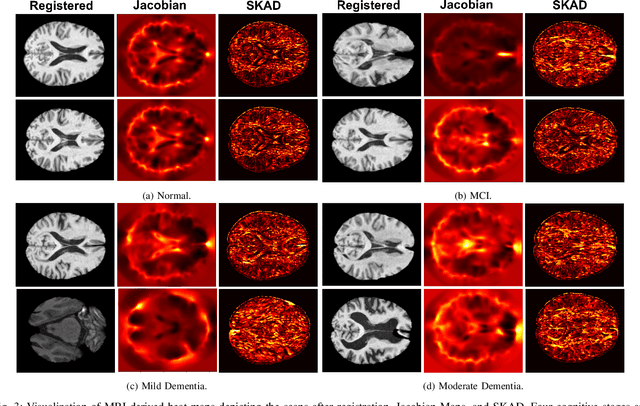
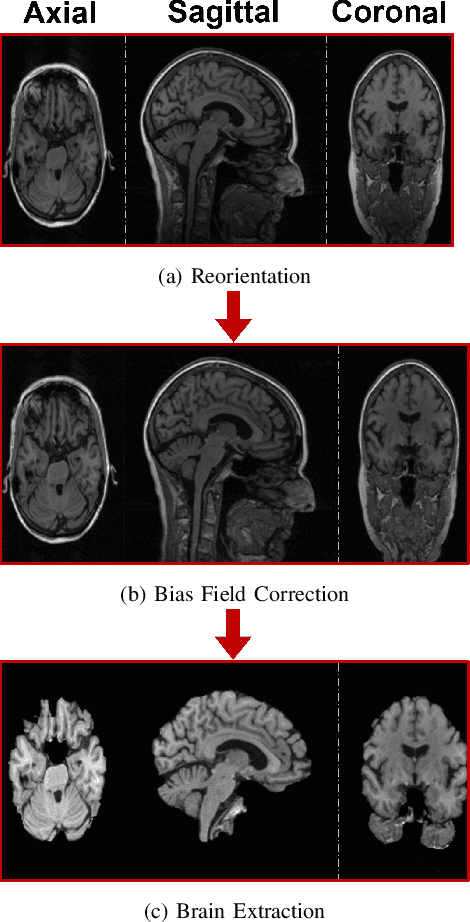
Abstract:Alzheimer's disease (AD) is characterized by progressive neurodegeneration and results in detrimental structural changes in human brains. Detecting these changes is crucial for early diagnosis and timely intervention of disease progression. Jacobian maps, derived from spatial normalization in voxel-based morphometry (VBM), have been instrumental in interpreting volume alterations associated with AD. However, the computational cost of generating Jacobian maps limits its clinical adoption. In this study, we explore alternative methods and propose Sobel kernel angle difference (SKAD) as a computationally efficient alternative. SKAD is a derivative operation that offers an optimized approach to quantifying volumetric alterations through localized analysis of the gradients. By efficiently extracting gradient amplitude changes at critical spatial regions, this derivative operation captures regional volume variations Evaluation of SKAD over various medical datasets demonstrates that it is 6.3x faster than Jacobian maps while still maintaining comparable accuracy. This makes it an efficient and competitive approach in neuroimaging research and clinical practice.
FisherMask: Enhancing Neural Network Labeling Efficiency in Image Classification Using Fisher Information
Nov 08, 2024



Abstract:Deep learning (DL) models are popular across various domains due to their remarkable performance and efficiency. However, their effectiveness relies heavily on large amounts of labeled data, which are often time-consuming and labor-intensive to generate manually. To overcome this challenge, it is essential to develop strategies that reduce reliance on extensive labeled data while preserving model performance. In this paper, we propose FisherMask, a Fisher information-based active learning (AL) approach that identifies key network parameters by masking them based on their Fisher information values. FisherMask enhances batch AL by using Fisher information to select the most critical parameters, allowing the identification of the most impactful samples during AL training. Moreover, Fisher information possesses favorable statistical properties, offering valuable insights into model behavior and providing a better understanding of the performance characteristics within the AL pipeline. Our extensive experiments demonstrate that FisherMask significantly outperforms state-of-the-art methods on diverse datasets, including CIFAR-10 and FashionMNIST, especially under imbalanced settings. These improvements lead to substantial gains in labeling efficiency. Hence serving as an effective tool to measure the sensitivity of model parameters to data samples. Our code is available on \url{https://github.com/sgchr273/FisherMask}.
CAV-AD: A Robust Framework for Detection of Anomalous Data and Malicious Sensors in CAV Networks
Jul 07, 2024Abstract:The adoption of connected and automated vehicles (CAVs) has sparked considerable interest across diverse industries, including public transportation, underground mining, and agriculture sectors. However, CAVs' reliance on sensor readings makes them vulnerable to significant threats. Manipulating these readings can compromise CAV network security, posing serious risks for malicious activities. Although several anomaly detection (AD) approaches for CAV networks are proposed, they often fail to: i) detect multiple anomalies in specific sensor(s) with high accuracy or F1 score, and ii) identify the specific sensor being attacked. In response, this paper proposes a novel framework tailored to CAV networks, called CAV-AD, for distinguishing abnormal readings amidst multiple anomaly data while identifying malicious sensors. Specifically, CAV-AD comprises two main components: i) A novel CNN model architecture called optimized omni-scale CNN (O-OS-CNN), which optimally selects the time scale by generating all possible kernel sizes for input time series data; ii) An amplification block to increase the values of anomaly readings, enhancing sensitivity for detecting anomalies. Not only that, but CAV-AD integrates the proposed O-OS-CNN with a Kalman filter to instantly identify the malicious sensors. We extensively train CAV-AD using real-world datasets containing both instant and constant attacks, evaluating its performance in detecting intrusions from multiple anomalies, which presents a more challenging scenario. Our results demonstrate that CAV-AD outperforms state-of-the-art methods, achieving an average accuracy of 98% and an average F1 score of 89\%, while accurately identifying the malicious sensors.
Stitching Satellites to the Edge: Pervasive and Efficient Federated LEO Satellite Learning
Jan 28, 2024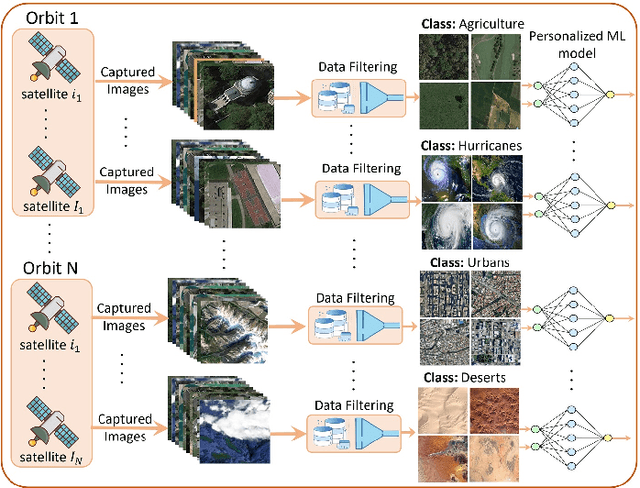
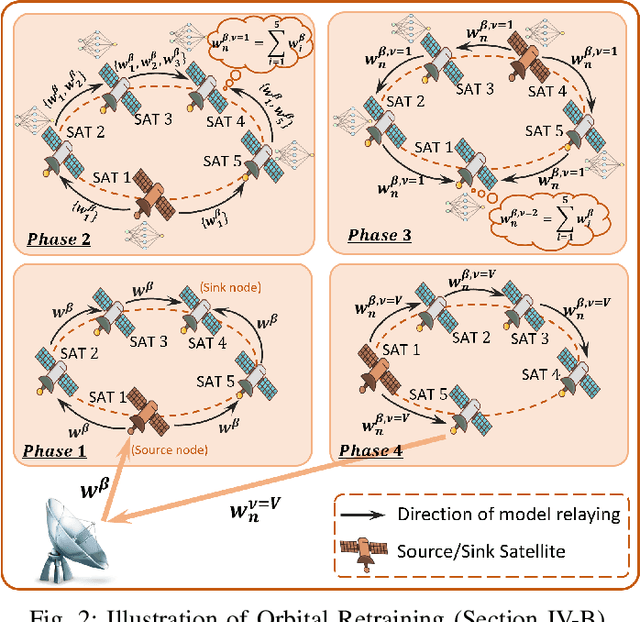
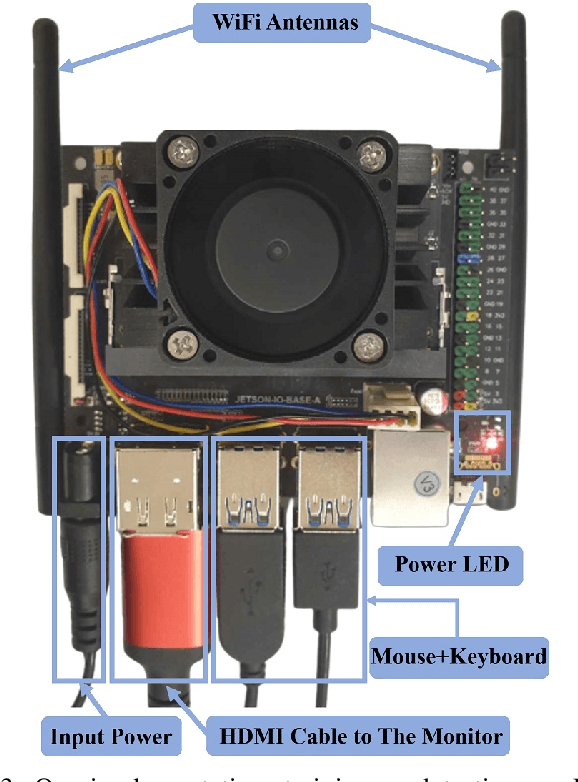
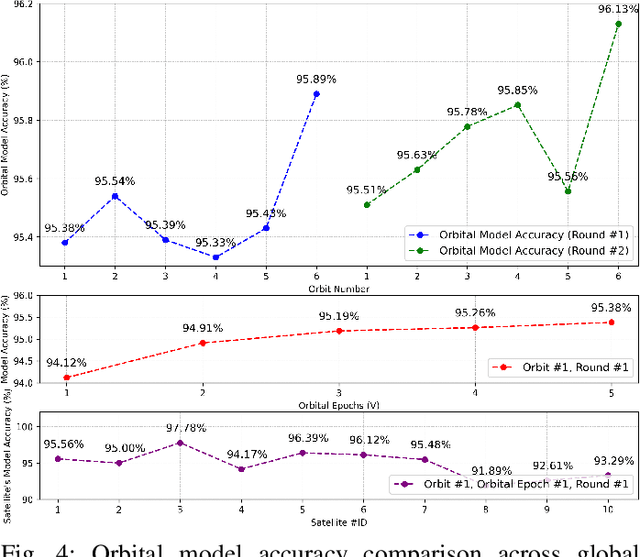
Abstract:In the ambitious realm of space AI, the integration of federated learning (FL) with low Earth orbit (LEO) satellite constellations holds immense promise. However, many challenges persist in terms of feasibility, learning efficiency, and convergence. These hurdles stem from the bottleneck in communication, characterized by sporadic and irregular connectivity between LEO satellites and ground stations, coupled with the limited computation capability of satellite edge computing (SEC). This paper proposes a novel FL-SEC framework that empowers LEO satellites to execute large-scale machine learning (ML) tasks onboard efficiently. Its key components include i) personalized learning via divide-and-conquer, which identifies and eliminates redundant satellite images and converts complex multi-class classification problems to simple binary classification, enabling rapid and energy-efficient training of lightweight ML models suitable for IoT/edge devices on satellites; ii) orbital model retraining, which generates an aggregated "orbital model" per orbit and retrains it before sending to the ground station, significantly reducing the required communication rounds. We conducted experiments using Jetson Nano, an edge device closely mimicking the limited compute on LEO satellites, and a real satellite dataset. The results underscore the effectiveness of our approach, highlighting SEC's ability to run lightweight ML models on real and high-resolution satellite imagery. Our approach dramatically reduces FL convergence time by nearly 30 times, and satellite energy consumption down to as low as 1.38 watts, all while maintaining an exceptional accuracy of up to 96%.
Communication-Efficient Federated Learning for LEO Constellations Integrated with HAPs Using Hybrid NOMA-OFDM
Jan 01, 2024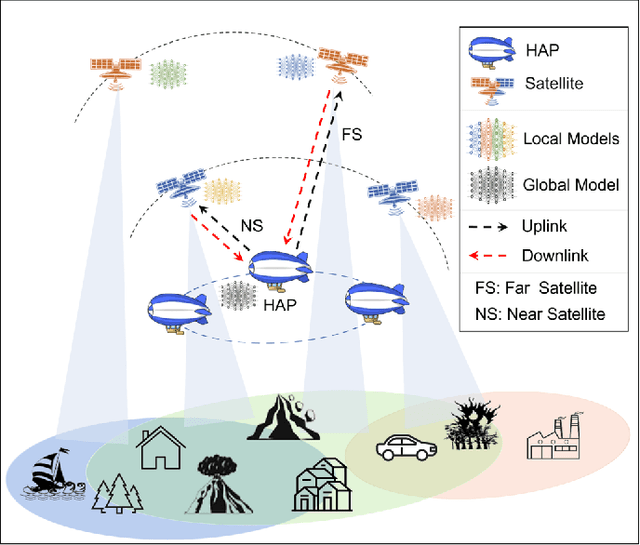
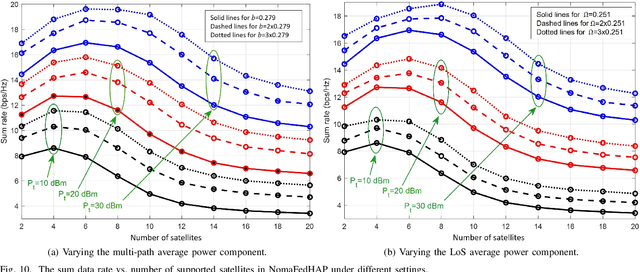
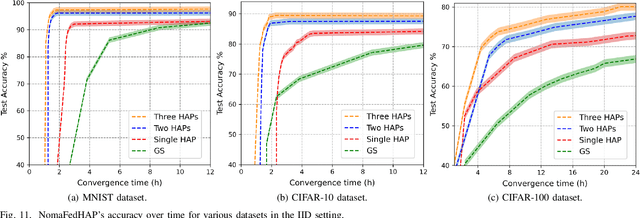

Abstract:Space AI has become increasingly important and sometimes even necessary for government, businesses, and society. An active research topic under this mission is integrating federated learning (FL) with satellite communications (SatCom) so that numerous low Earth orbit (LEO) satellites can collaboratively train a machine learning model. However, the special communication environment of SatCom leads to a very slow FL training process up to days and weeks. This paper proposes NomaFedHAP, a novel FL-SatCom approach tailored to LEO satellites, that (1) utilizes high-altitude platforms (HAPs) as distributed parameter servers (PS) to enhance satellite visibility, and (2) introduces non-orthogonal multiple access (NOMA) into LEO to enable fast and bandwidth-efficient model transmissions. In addition, NomaFedHAP includes (3) a new communication topology that exploits HAPs to bridge satellites among different orbits to mitigate the Doppler shift, and (4) a new FL model aggregation scheme that optimally balances models between different orbits and shells. Moreover, we (5) derive a closed-form expression of the outage probability for satellites in near and far shells, as well as for the entire system. Our extensive simulations have validated the mathematical analysis and demonstrated the superior performance of NomaFedHAP in achieving fast and efficient FL model convergence with high accuracy as compared to the state-of-the-art.
 Add to Chrome
Add to Chrome Add to Firefox
Add to Firefox Add to Edge
Add to Edge